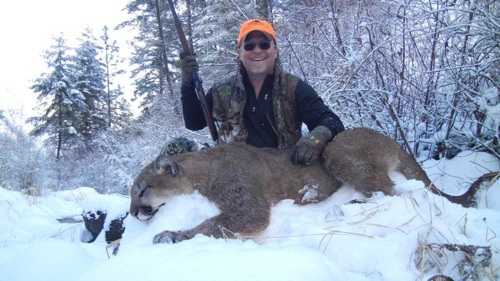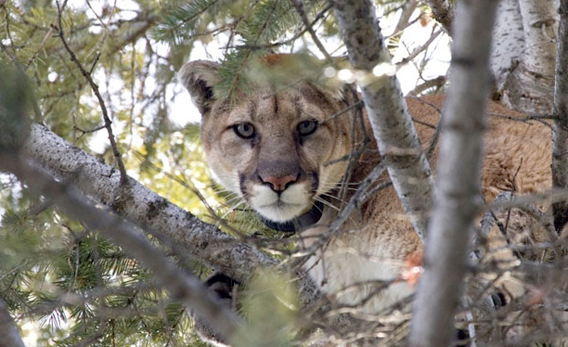Senseless mountain lion and wolf hunting, contrary to the assertions of “sportsmen,” does not manage wildlife habitat, merely degrades healthy functioning of ecosystems.


“Save an Elk (for me to kill), Shoot a Cougar or Wolf”
Mountain lion sport hunting, contrary to the assertions of many “sportsmen” does not provide a service of managing wildlife habitat. The recent legal killing of a cougar by California Fish and Game Commissioner Dan Richards, on a free-of-charge guided hunt (not “canned” but definitely “gifted”) on Idaho’s Flying B Ranch in Kamiah, Idaho, illustrates the senseless need for (usually) white men to shoot thriving wild animals for fun. The hunt was justified by the manager of the Flying B as follows:
“Some elk populations are down 85 percent (due to predation). It was an extra favor to me. Richards was helping manage wildlife here on my ranch,” Flying B manager Joseph Peterson said. With deer populations dramatically down, Peterson needed to cull three lions from the 5,000-acre property. “We saw a lot more; we let them go,” he said.
Elk populations have plummeted in certain regions of the west, but not close to Mr. Peterson’s assertions. Studies by the Idaho Department of Fish and Game (IDFG 2010) show elk population has declined 20 percent over the last 15 years, dropping from 125,000 to 103,000.
According to IDFG Wildlife Biologist Craig White, elk population trends depend on the survival rates of cow elk and calves. Elk survival depends primarily on four factors: nutrition, hunter harvest, predation, and weather (climate). He fails to mention the reduction of habitat from livestock ranching and tourism development, including road densities, trucking routes, mining and logging, and ski-condo-sprawl.
In general, according to hunter and ecologist George Wuerthner, predators will have minimum effects on hunting. Even now in Wyoming, Montana, and Idaho, most elk populations are at or above “management objectives.” Climatic conditions and habitat quality typically have a far greater impact on long-term viability of huntable species than predators.
STORY: Idaho: Wolves and Wilderness Persist in the Bitterroot Mountains
State Wildlife Commission Anti-Predator Bias
We see, as Mr. Wuerthner asserts, not necessarily objective, nor scientific state wildlife agencies calling for wolf, cougar, and bear killing. Top predators directly threaten state wildlife budgets (funded by license sales) because they eat the very elk and deer that licensed hunters want to kill. While wildlife biologists usually have a balanced approach, their politically-appointed commissions that “represent primarily rural residents, timber companies and agricultural interests—all of whom are generally hostile to predators and/or see it as almost a God-given requirement that humans manage the Earth to ‘improve’ it and fix the lousy job that God did by creating wolves and mountain lions.”
In this regard, while California Fish and Game Commission President Daniel Richards flaunting his trophy mountain lion shows poor judgement, it is not alone reason for him to resign. His acceptance of the guided hunt as a free gift, however, worth more than the limits allowable under California law for appointed and elected officials, has led to an ethics complaint.
His prior record, in addition, suggests a compromised conservation integrity, described by the Los Angeles Times as “an abysmal steward of wildlife and an obstructionist rather than a conservationist.”
The Upland real estate developer has voted against listing a declining amphibian as threatened; voted against protecting the rare mammal, Pacific Fisher; he has passionately advocated against efforts to stop the use of toxic lead shot in California’s condor habitat; and also opposed with vehemence the Marine Life Protection Act. Thankfully a majority of the commission disagreed with him and approved these protections.
The commission oversees the state’s Fish and Game management plans that protect wildlife while providing recreational hunting opportunities. Animal populations must be addressed, particularly with regard to the wishes of Californians, less than 1% of whom hunt. As the state faces unprecedented threats from development, habitat loss, poaching and climate change, the commission must get with the program, and Mr. Richards can seek a position in Idaho. Or not.
STORY: Jerry Collamer: Mountain Lion Tastes Like Pork Loin


Predators as Ecosystem Regulators
From the CounterPunch article, George Wuerthner asserts top predators play a crucial ecological role in maintaining ecosystem stability and integrity. In addition, predators, more than most other species, have well developed social structures that demand a much more nuanced approach to human/wildlife relationships than most wildlife agencies are prepared to deal with, much less even acknowledge.
As top-down regulators of ecosystems, predators like wolves, mountain lion, and bears help to reduce herbivore numbers to slow or reduce over-browsing or overgrazing of plant communities. This, in turn, leads to thriving of willow and aspen, home to beavers, which build dams, ponds, and increase wetland habitat.
But wolf-induced habitat shifts by elk has had other benefits as well, documented in Yellowstone National Park. Since the road system there and beyond tends to follow river valleys, movement of elk away from streams to adjacent uplands increases the likelihood that a certain percentage of the animals will die further from a road. This has important consequences for grizzly bears that have been shown to avoid feeding on carcasses located close to roads. Finding even one more elk carcass in the spring in a place that is “safe” for feeding is like winning the lottery for, say, a mother grizzly with several cubs to feed.
Some scientists have even postulated that wolves may ameliorate the effects of climate change on scavenger species by providing carrion throughout the year. Predators can also limit the effects of disease, like chronic wasting disease found in elk, deer, and moose since infected animals are more vulnerable to predators.
The presence of a large predator has a cascading effect on all other predators as well. For instance, the present of wolves results in fewer coyotes. Since coyotes are among the major predators on pronghorn fawns, presence of wolves, has led to higher pronghorn fawn survival.
And because of the single-minded bias of state wildlife agencies for maintaining large numbers of huntable species, they fail to even ask whether predation might have a positive influence on ecosystem sustainability.
For instance, in certain circumstances, top predators like wolves, bears, and mountain lions will hold prey populations low for an extended period of time, especially if habitat quality is marginal for the herbivores. These “predator sinks” provide the long term “rest” from herbivory pressure that plant communities may require on occasion to reestablish or recover from past herbivory pressure. Almost universally when predators begin to “hold down” prey populations, state agencies want to kill them so the targeted populations of moose, caribou, elk, deer, or whatever it might be can “recover.” That is the justification, for instance, for the continued slaughter of up to 100 wolves near Lolo Pass by the Idaho Fish and Game.
Unfortunately for predators if their numbers are sufficiently high for them to have these ecological effects on other wildlife as well as the plant communities, state wildlife agencies tend to view them as too high for their “management objectives.”
Updated 26 February 2019









It is unfathomable to me that we fat and happy Americans feel it necessary to try to eradicate our “competition” for wild meat when we can go to Safeway and buy porkchops. Come on, people, grow up! These hunts don’t mean life or death to you, but they do to the cougars and wolves.
Pingback: Idaho Mountain Lion Tastes Like Pork Loin - By Jerry Collamer | WilderUtopia.com
Pingback: Habitat Conservation Saves Grizzly Bears, Not Hunters | WilderUtopia.com
The argument is completely destroyed when one realizes that this earth regulated itself for four billion years without our involvement and never once needed humans to manage anything.
Pingback: On Mountain Lions: How to Embrace our Wild Predatory Relatives - WilderUtopia